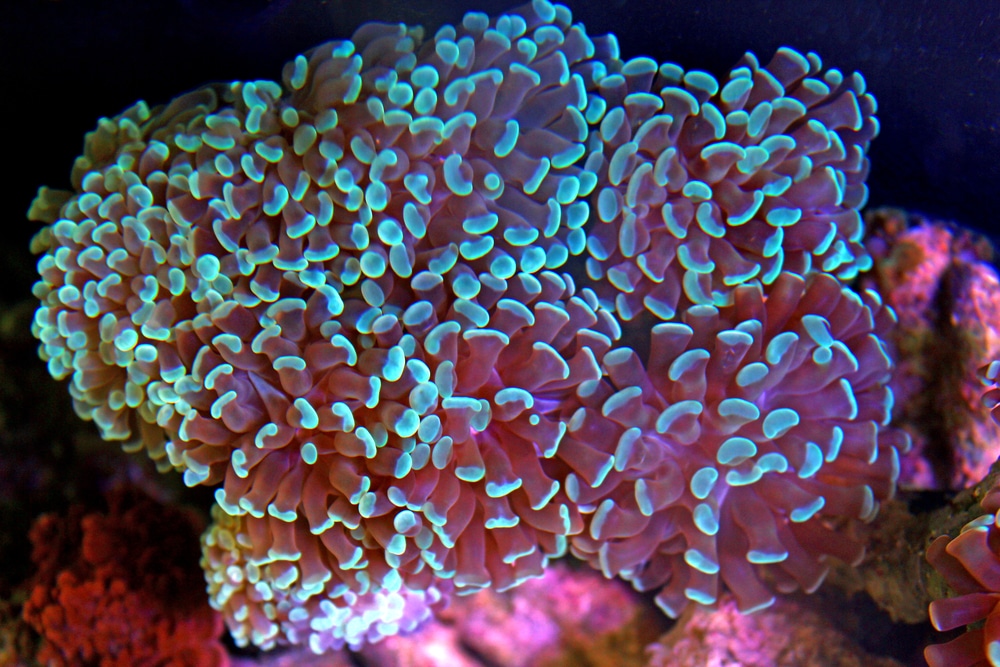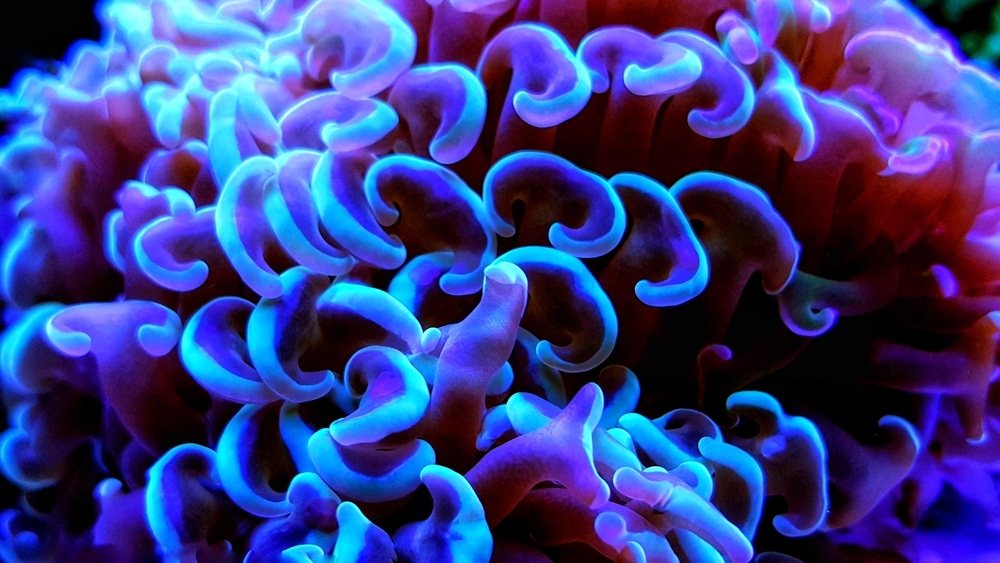Reef aquarists have a wide variety of coral species to choose from that vary tremendously in difficulty. If you’re new to the world of reef tanks and looking for something dramatic but not too difficult, the Hammer Coral is well worth taking a look at.
Hammer Coral is right in the middle of the pack when it comes to care requirements. However they look very different from other stony corals and are easy to find in the hobby. Lastly, they are both inexpensive and easily fragged as they grow, allowing you to share these corals with your friends.
What is Hammer Coral?
Hammer Coral is very similar in appearance to its close relatives, Torch Coral (Euphyllia glabrescens) and Frogspawn Coral (Euphyllia divisa). All three are very flesh corals with bulbous tentacles; very unusual for LPS (large polyp stony) corals.
Hammer Corals get their name from the tips of their tentacles, which have a flared appearance like the end of a hammer. That said, the effect isn’t consistent – some may have more of an anchor or T-shape. And sometimes they look more like Torch or Frogspawn Corals.
Hammer Corals can look somewhat like sea anemones with a stony coral base. And like anemones Hammer Corals use their tentacles to eat. The short feeding tentacles are used to actively snatch prey out of the water and tend to move and quest about seeking tasty animals.
Euphyllia corals can live entirely off of their zooxanthellae (symbiotic algae). But they grow much quicker and more robustly if given occasional feedings.
Hammer Corals and their relatives are infamous for being some of the more aggressive corals in the hobby. “Aggressive” seems like a strange way to describe an animal that can’t really move but we’ll get to that soon enough. Coral warfare is one of the most dynamic aspects to the world of reef keeping and something you’ll need to account for.
That said, Hammer Coral tends to get along well with its relatives. Torch Corals aren’t always so loving but both Hammer and Frogspawn Corals can often be kept side by side with few to no issues.
So how does one care for these gorgeous, if mean, corals!
- Common Names: Hammer Coral
- Scientific Name: Euphyllia ancora
- Origin: Indopacific Ocean
- Size: Up to 30 inches in nature
- Aquarium Size: 30+ gallons
- Temperament: Aggressive
- Ease of Care: Moderate

Caring for Hammer Corals
As one of the least difficult LPS corals in the hobby, Hammer Corals are a good species for any hobbyist that understands the foundations of reef keeping!
Aquariums for Hammer Corals
In nature Hammer Coral colonies can reach nearly 3 feet in diameter! But that will take many years and the largest of aquariums to achieve in captivity. Smaller corals can be kept in aquariums of nearly any size as they grow. And if your coral grows too big it can be split into frags (more on that later).
But if you want to keep Hammer Corals alongside other kinds of coral then you should go with a somewhat spacious aquarium. 30 gallons or more ensures that you can properly space your corals because Hammer Coral is very aggressive.
At night, these corals extend sweeper tentacles, which are offensive organs packed with nematocysts (stinging tentacles). Sweeper tentacles can reach up to 6 inches beyond the feeding tentacles of your Hammer Coral and attack anything they come in contact with.
Other corals that are growing too close are repeatedly stung as the sweepers sway in the current until they dislodge, fight back, or die. So you’ll need to account for this aggression when aquascaping. Since Hammer Corals enjoy water flow you can also use current to ensure the sweeper tentacles stay clear of nearby corals.
Hammer Corals require moderate light intensity; not too dim but not too bright. They also color up beautifully under blue/purple actinic lighting. They have intense fluorescent blue, green, and occasionally even orange tones.
Do keep in mind that actinic lights are mainly for viewing purposes. The color temperature is above 10,000K and strongly violet. They make corals look even more lovely but you’ll need to pair them with a white light in order to give them enough PAR (photosynthetically active radiation) they need for photosynthesis.
Lights around 6700K in temperature fuel growth because they are ideal for photosynthesis but have a more yellow/white color cast. Combined with an actinic bulb you get the best of both worlds!

Water Conditions
One of the main challenges in keeping hard corals is balancing their needs for some water nutrients with cleanliness. While Hammer Corals require excellent water conditions you don’t want to remove all nutrients.
Many nutrients, such as nitrate, are required in small amounts because they are algae nutrients. But too much nitrate in the water will cause non-symbiotic algae to grow, which can coat the corals and smother them to death.
So we need to shoot for a very low but non-zero concentration of nitrates. Anywhere from 1-10ppm is ideal for Hammer Corals and should be easy to maintain in an established aquarium with fish and other animals.
Like all Euphyllia sp, Hammer Corals also enjoy a slow to moderate water current. Water movement helps the coral shed mucus and keeps the tentacles active and questing about for any food that might float by.
Water flow can also be used to ensure the sweeper tentacles don’t stray onto corals in the opposite direction, helping you pack the tank. But don’t give the coral too much current as a strong current can cause it to retract or even bruise it.
Like all stony coral, Hammer Corals also need dissolved minerals to add onto their hard skeletons. Calcium is the most important agent, as is magnesium, which makes calcium bioavailable. You’ll also want trace elements, such as strontium, all of which can be found in a good coral reef supplement.
Hammer Coral Water Conditions
- Temperature: 75-82℉
- pH: 7.9-8.2
- Specific Gravity: 1.023-1.024
- Alkalinity: 9-11 DKH
- Calcium: 400-450 ppm
- Magnesium: 1200-1350 ppm
- Nitrate: 1-10ppm
- Flow: Gentle to Moderate
Feeding Hammer Corals
Hammer Corals don’t require food but it helps if you want to see them grow more quickly and fully. They get very little food in nature so you don’t need to feed them often. In fact, if you’re concerned about leftover food, waste products, or the general hassle of feeding, you can allow them to live solely off of photosynthesis.
If you want to feed your Hammer Coral, aim for 2-3 times a week. Hammer Corals are carnivorous and prefer tiny invertebrates as prey. Frozen brine or mysis shrimp are by far the most convenient food to keep on hand.
Simply thaw out the shrimp, turn off the water flow, and drop a few shrimp onto each “head” of the coral (assuming it has a branching growth pattern). It doesn’t take very much – the coral will gorge itself if you offer more.
But remember these animals not only make their own food but don’t move much. All excess food will do is contribute to poor water quality.
We also want to be precise in our feeding for this reason. Don’t simply broadcast food into the water column as the majority of this will go to waste. Target feed each coral using a coral feeding pipette or tongs.
Tank Mates for Hammer Corals
Choosing tank mates for Hammer Corals can be a bit of a challenge due to their aggression. New aquarists often look at corals and see a peaceful living jungle but nothing could be further from the truth.
The reef aquarium is as ruthless and competitive an environment as any other. Corals are busy spewing noxious compounds into the water that poison nearby corals, coating themself in poisonous mucus in case they brush up against a neighbor, and stinging other corals that grow too close with far-reaching sweeper tentacles.
A lot of these problems are made worse in an aquarium where coral toxins may build up and corals get crammed together in unnatural ways.
That said, Hammer Corals do get along with their relatives, Torch and Frogspawn Corals. These species can be kept side by side and make for a beautiful display just on their own.
Hammer Coral can also be kept with any fish or invertebrate that’s reef safe. This includes Tangs, smaller Damselfish, Gobies, Blennies, and Mandarin Gobies.
You can also try many Dwarf Angelfish (Centropyge sp.). These fish are stunning, small, mostly peaceful, and easy to find. But they do need to be kept well fed as they are grazers by nature.
Dwarf Angelfish mostly eat algae and other encrusting organisms but they may pick at corals if they aren’t getting enough food. Some of the best for reefs include the Flame (Centropyge loriculus), Potter’s (Centropyge potteri), and Pygmy Dwarf or Cherub Angelfish (Centropyge argi).
Lastly, Clownfish are excellent tank mates because many of them will host Hammer Corals. Clownfish can be a bit intense with how often they burrow into the coral so watch it for signs of stress when first introduced.
Reef safe invertebrates include Feather Duster worms, many Starfish, Clams, and most shrimp, including Scarlet Skunk Cleaner Shrimp (Lysmata amboinensis), Pistol Shrimp (Alpheus sp.), and Banded Coral Shrimp (Stenopus hispidus).
Watch out for Peppermint Shrimp (Lysmata wurdemanni), though. These little guys are beautiful and common in the hobby because they have an appetite for pest Aiptasia sea anemones. But they are known to also pick at Hammer Corals.
Good Tank Mates for Hammer Corals:
- Tangs, Clownfish, smaller Damselfish, Gobies, and other reef-safe fish
- Pygmy Angelfish (with caution)
- Most invertebrates
- Other Corals (with caution)
Poor Tank Mats for Hammer Corals:
- Corals, Sea Anemones, and other sessile invertebrates that are too close
- Peppermint Shrimp and other Coral-eaters
Propagating Hammer Corals
Once you’ve mastered the essentials of keeping Hammer Corals alive propagating them artificially is a great way to share them with your friends. In nature Hammer Corals reproduce both sexually and asexually.
They have distinct male and female sexes but they take several months to generate enough gametes (eggs and sperm) to breed. Corals rely on seasonal cues from their environment to coordinate mass spawnings. Specifically the tides and lunar light are what trigger them.
At the right season the corals will release huge clouds of gametes into the water where they mix and fertilize. The coral larvae then spend weeks among the plankton, consuming and being consumed by other organisms. Eventually the young coral settle back onto the reef and begin building a skeletal structure as they form new colonies and compete for space.
Mass spawnings are extremely unlikely in home aquariums because the seasonal cues aren’t there. Instead, you can frag your corals into pieces that then grow into clones of the original colony!
In order to frag your coral, you’ll need a few supplies. Mainly a coral fragging kit. But this also depends on whether your coral has a wall or branching growth pattern.
Wall corals grow in a flat plate and need to be split using a bandsaw or other heavy duty cutting equipment. Since a wall Hammer Coral colony will have its flesh cut in the process you’ll also need to prepare an iodine soak as a disinfectant once you’ve cut the colony in half. But most healthy Hammer Corals survive the splitting process just fine!
Branching corals can be clipped with strong enough shears or cut using a dremel if they are thicker. Once clipped you can use superglue to attach each individual branch onto a fragging disk or a bit of coral rubble. These new colonies will then grow of their own accord and form branches of their own!

